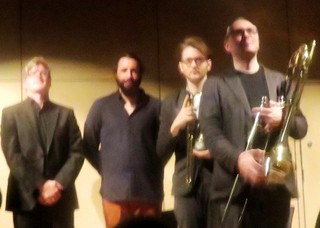|
Back
Sounds Both Special and Spatial New York
Austrian Cultural Forum, 11 East 52nd Street
12/01/2017 -
Daniel Riegler: HOMO FABER
Christian F. Schiller: HOHNOR (World Premiere)
Studio Dan: Sophia Goidinger-Koch (Violin), Maiken Beer (Violoncello), Manuel Mayr (Bass), Thomas Frey, Michael Tiefenbacher (Harmonicas), Mathias Koch (Drums), Clemens Salesny (Drums Assistant), Dominik Fuss (Trumpet), Daniel Riegler (Trombone)
Caitlin Smith (Production)

A. Reinhart’s Black On Black (© Whitney.org)
“Everything is on the move. Art should be still.”
Ad Reinhart (1913-1967), about his Black On Black paintings
It was impossible not to imagine Ad Reinhart’s abstract, mystical monochromatic paintings during the second half of the Austrian Cultural Center performance last night.
Composer Christian F. Schiller had devised a colorful ensemble to perform his HOHNOR, from the Studio Dan Ensemble. One violin, one cello, one double bass (the amazing Manuel Mayr), one strange-looking trumpet, drums, and trombone from Daniel Riegler, who had composed the work which opened the concert. Plus, in the center, two harmonicas.
As a one-time harmonicist, I wondered what they would do. But the answer–as in a black-upon-black canvas–was that nobody did much of anything. The motionless was illusory (see below) but seemed at the time perfectly static.
Perhaps this was inspired by the title, “Hohn” is the German for scorn, so the neologism means “Honor/Scorn”.
“Aha,” thought I, as the first dark microtonal soft buzzing came from the pair of harmonica players in the lowest range, triple-tonguing their notes to increase the buzz. “Now we’ll crescendo into so-called ‘honor’ and then deconstruct the word with the scorn it deserves.”
Except that nothing really advanced after those first low trilling notes by all the instruments. Low, bleak, black, and in Ad Reinhart’s words, “the art of stillness.” Mr. Riegler raised his trombone a bit, but this was out of place in such a near-religious stasis. In fact, just believing that it would lift itself from the abyss gave my own mind a psychological jolt. Like the dichotomy of the title, my aesthetic mind (not my thoughts, which were glued to the music) was advancing ahead, before being pulled back to the reality of the singleness of the music.
My mind had enjoyed an aural illusion of kinetic movement. Mr. Schiller’s mind had the reality of utter stillness. Though that was not quite true.
Like the palimpsest of the paintings, the cover sounds of the ensemble were altering by microtonal movements. Not resembling the motions of, say Steve Reich’s music, but within their own cells, changing around with quark-like alterations.

T. Frey, M. Tiefenbacher, D. Fuss, D. Riegler (© Samuel A. Dog)
Like Reinhart’s paintings, there were brief diversions, little ripples. And at the end of the first movement, we had real action. One of the two harmonica players slowly, elegantly disassembled his instrument, reverently placing each piece on a metal table.
He never blew another note, looking straight ahead...except in one part–the climax?–when he came close to his partner, and like a lover, put his lips on the sounding system of the instrument, exhaled, inhaled and then stayed by himself.
The last section would be described as infinite ppppp, each instrument whispering, then silence, then applause.
HOHNOR thus came to an inconclusive, but strangely fascinating end. It was blessedly short, always intriguing, even captivating. Mr. Schiller, unlike so many composers, understood brevity, never let this go on too far. And for those illusions and contentment, we could all be thankful.
One knows that a visit to the Austrian Cultural Forum inevitably has musical amazements. Unlike American composers today, who are open, free-wheeling, who long ago rejected Babbitt atonality for Glass-like transparency, the composers of Austria and Germany, while accepting jazz (like jazz trombonist Daniel Riegler) never shun complexity and arcane compositions.
So it was with anticipatory dread that I watched trombonist Mr. Riegler and his trio of electronic violin, cello and bass proceed with HOMO FABER, which the Roman poets wrote for “man the tool-maker” or more specifically here, ”man the creator”. Or in the case of Mr. Riegler, five movements of spatial and microtonal harmonies and rhythms.
They were all different, all appealing. Initially one was transfixed by the three string instruments playing pizzicati, all in almost impalpable microseconds of each other. This, though, followed by more resonant sounds both n the frets and the instruments, led by bassist Mayr performing the most astounding series of glissandi.
These, though, were within the contained space of the stage. At different times, Mr. Riegler walked to the back of the auditorium for his growly flatulence, at times, violinist Koch and cellist Beer strolled to the balcony or out the door backstage. At other times, the usual white-tone electronics pierced through the stage.
I almost forgot to mention near-inaudible German text between the movements, and the visuals on a screen above the musicians. The latter because they were so forgettable. In a sterile white series of chambers resembling an Ikea showroom, were tin-metal objects, resembling nothing. (One looked like a praying mantis, the rest were abstract.)
One could avoid that, because Mr. Riegler’s work–whatever philosophical import it might have had–was still always interesting, original and played by four extreme virtuosi.
Harry Rolnick
|